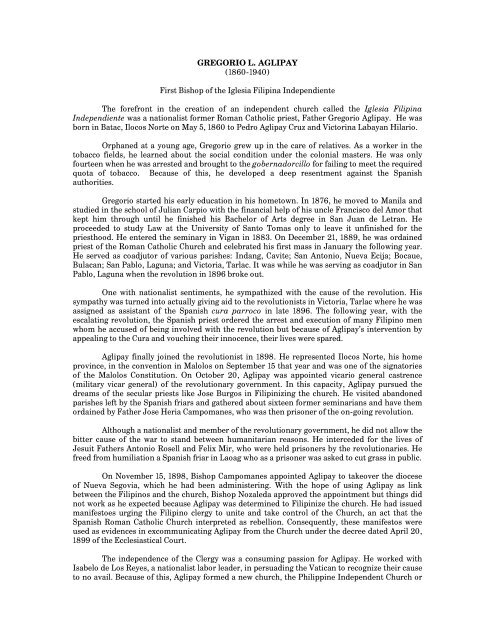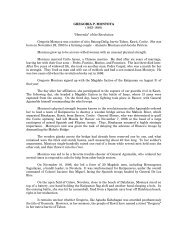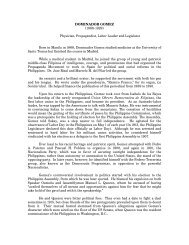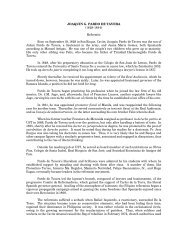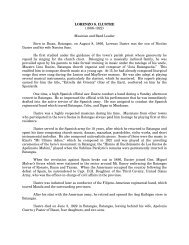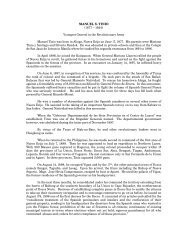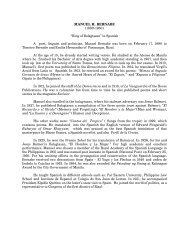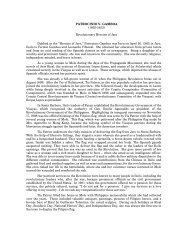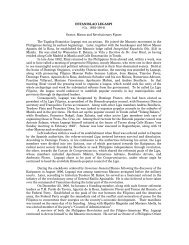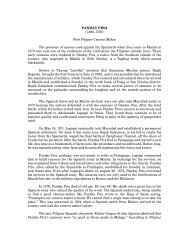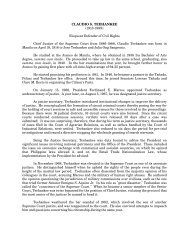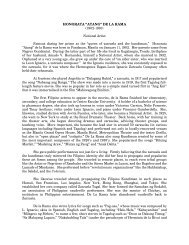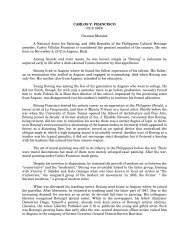GREGORIO L. AGLIPAY (1860-1940) First Bishop of the Iglesia ...
GREGORIO L. AGLIPAY (1860-1940) First Bishop of the Iglesia ...
GREGORIO L. AGLIPAY (1860-1940) First Bishop of the Iglesia ...
You also want an ePaper? Increase the reach of your titles
YUMPU automatically turns print PDFs into web optimized ePapers that Google loves.
<strong>GREGORIO</strong> L. <strong>AGLIPAY</strong><br />
(<strong>1860</strong>-<strong>1940</strong>)<br />
<strong>First</strong> <strong>Bishop</strong> <strong>of</strong> <strong>the</strong> <strong>Iglesia</strong> Filipina Independiente<br />
The forefront in <strong>the</strong> creation <strong>of</strong> an independent church called <strong>the</strong> <strong>Iglesia</strong> Filipina<br />
Independiente was a nationalist former Roman Catholic priest, Fa<strong>the</strong>r Gregorio Aglipay. He was<br />
born in Batac, Ilocos Norte on May 5, <strong>1860</strong> to Pedro Aglipay Cruz and Victorina Labayan Hilario.<br />
Orphaned at a young age, Gregorio grew up in <strong>the</strong> care <strong>of</strong> relatives. As a worker in <strong>the</strong><br />
tobacco fields, he learned about <strong>the</strong> social condition under <strong>the</strong> colonial masters. He was only<br />
fourteen when he was arrested and brought to <strong>the</strong> gobernadorcillo for failing to meet <strong>the</strong> required<br />
quota <strong>of</strong> tobacco. Because <strong>of</strong> this, he developed a deep resentment against <strong>the</strong> Spanish<br />
authorities.<br />
Gregorio started his early education in his hometown. In 1876, he moved to Manila and<br />
studied in <strong>the</strong> school <strong>of</strong> Julian Carpio with <strong>the</strong> financial help <strong>of</strong> his uncle Francisco del Amor that<br />
kept him through until he finished his Bachelor <strong>of</strong> Arts degree in San Juan de Letran. He<br />
proceeded to study Law at <strong>the</strong> University <strong>of</strong> Santo Tomas only to leave it unfinished for <strong>the</strong><br />
priesthood. He entered <strong>the</strong> seminary in Vigan in 1883. On December 21, 1889, he was ordained<br />
priest <strong>of</strong> <strong>the</strong> Roman Catholic Church and celebrated his first mass in January <strong>the</strong> following year.<br />
He served as coadjutor <strong>of</strong> various parishes: Indang, Cavite; San Antonio, Nueva Ecija; Bocaue,<br />
Bulacan; San Pablo, Laguna; and Victoria, Tarlac. It was while he was serving as coadjutor in San<br />
Pablo, Laguna when <strong>the</strong> revolution in 1896 broke out.<br />
One with nationalist sentiments, he sympathized with <strong>the</strong> cause <strong>of</strong> <strong>the</strong> revolution. His<br />
sympathy was turned into actually giving aid to <strong>the</strong> revolutionists in Victoria, Tarlac where he was<br />
assigned as assistant <strong>of</strong> <strong>the</strong> Spanish cura parroco in late 1896. The following year, with <strong>the</strong><br />
escalating revolution, <strong>the</strong> Spanish priest ordered <strong>the</strong> arrest and execution <strong>of</strong> many Filipino men<br />
whom he accused <strong>of</strong> being involved with <strong>the</strong> revolution but because <strong>of</strong> Aglipay’s intervention by<br />
appealing to <strong>the</strong> Cura and vouching <strong>the</strong>ir innocence, <strong>the</strong>ir lives were spared.<br />
Aglipay finally joined <strong>the</strong> revolutionist in 1898. He represented Ilocos Norte, his home<br />
province, in <strong>the</strong> convention in Malolos on September 15 that year and was one <strong>of</strong> <strong>the</strong> signatories<br />
<strong>of</strong> <strong>the</strong> Malolos Constitution. On October 20, Aglipay was appointed vicario general castrence<br />
(military vicar general) <strong>of</strong> <strong>the</strong> revolutionary government. In this capacity, Aglipay pursued <strong>the</strong><br />
dreams <strong>of</strong> <strong>the</strong> secular priests like Jose Burgos in Filipinizing <strong>the</strong> church. He visited abandoned<br />
parishes left by <strong>the</strong> Spanish friars and ga<strong>the</strong>red about sixteen former seminarians and have <strong>the</strong>m<br />
ordained by Fa<strong>the</strong>r Jose Heria Campomanes, who was <strong>the</strong>n prisoner <strong>of</strong> <strong>the</strong> on-going revolution.<br />
Although a nationalist and member <strong>of</strong> <strong>the</strong> revolutionary government, he did not allow <strong>the</strong><br />
bitter cause <strong>of</strong> <strong>the</strong> war to stand between humanitarian reasons. He interceded for <strong>the</strong> lives <strong>of</strong><br />
Jesuit Fa<strong>the</strong>rs Antonio Rosell and Felix Mir, who were held prisoners by <strong>the</strong> revolutionaries. He<br />
freed from humiliation a Spanish friar in Laoag who as a prisoner was asked to cut grass in public.<br />
On November 15, 1898, <strong>Bishop</strong> Campomanes appointed Aglipay to takeover <strong>the</strong> diocese<br />
<strong>of</strong> Nueva Segovia, which he had been administering. With <strong>the</strong> hope <strong>of</strong> using Aglipay as link<br />
between <strong>the</strong> Filipinos and <strong>the</strong> church, <strong>Bishop</strong> Nozaleda approved <strong>the</strong> appointment but things did<br />
not work as he expected because Aglipay was determined to Filipinize <strong>the</strong> church. He had issued<br />
manifestoes urging <strong>the</strong> Filipino clergy to unite and take control <strong>of</strong> <strong>the</strong> Church, an act that <strong>the</strong><br />
Spanish Roman Catholic Church interpreted as rebellion. Consequently, <strong>the</strong>se manifestos were<br />
used as evidences in excommunicating Aglipay from <strong>the</strong> Church under <strong>the</strong> decree dated April 20,<br />
1899 <strong>of</strong> <strong>the</strong> Ecclesiastical Court.<br />
The independence <strong>of</strong> <strong>the</strong> Clergy was a consuming passion for Aglipay. He worked with<br />
Isabelo de Los Reyes, a nationalist labor leader, in persuading <strong>the</strong> Vatican to recognize <strong>the</strong>ir cause<br />
to no avail. Because <strong>of</strong> this, Aglipay formed a new church, <strong>the</strong> Philippine Independent Church or
<strong>Iglesia</strong> Filipina Independiente, on August 3, 1902. During <strong>the</strong> Church launching, Isabelo de los<br />
Reyes named Aglipay as its Supreme <strong>Bishop</strong>. This finally sealed Aglipay’s separation with <strong>the</strong><br />
Roman Catholic Church. On October 1, 1902, <strong>the</strong> first constitution <strong>of</strong> <strong>the</strong> <strong>Iglesia</strong> Filipina<br />
Independiente was approved, signed, and promulgated in Sibakong, Manila. Twenty-Six days<br />
after <strong>the</strong> signing <strong>of</strong> <strong>the</strong> constitution, Supreme <strong>Bishop</strong> Aglipay celebrated his first mass.<br />
<strong>Bishop</strong> Aglipay, however, had not left <strong>the</strong> cause <strong>of</strong> <strong>the</strong> 1896 Revolution. During <strong>the</strong><br />
Filipino-American War, he fought actively with his guerrilla unit against <strong>the</strong> Americans.<br />
Realizing <strong>the</strong> futility <strong>of</strong> fighting <strong>the</strong> well-equipped American soldiers, he surrendered to Colonel<br />
MacCaskey in Laoag and resumed his leadership in <strong>the</strong> Church.<br />
In 1931, Gregorio traveled to <strong>the</strong> United States on invitation <strong>of</strong> <strong>the</strong> Unitarian Churches <strong>of</strong><br />
America to attend a conference. A nationalist, Aglipay tried to transform his leadership in <strong>the</strong><br />
political arena. He ran for president in <strong>the</strong> 1935 election under <strong>the</strong> Republican Party but lost to<br />
Manuel L. Quezon. On March 12, 1939, Aglipay married Pilar Jamias from Sarrat, Ilocos Norte.<br />
On September 1, <strong>1940</strong>, <strong>Bishop</strong> Aglipay died in Manila <strong>of</strong> cerebral hemorrhage and was<br />
buried in his hometown in Batac, Ilocos Norte.<br />
References:<br />
Agoncillo, Teodoro A. History <strong>of</strong> <strong>the</strong> Filipino People 8 th ed. Quezon City:<br />
Garotech, 1990.<br />
Cornejo, Miguel. Commonwealth Directory <strong>of</strong> <strong>the</strong> Philippines. Pasay City, 1939.<br />
Fonacier, Tomas S. Gregorio Aglipay Y Labayan: A Short Biography. Manila:<br />
McCullough Printing Co., 1954.<br />
Zaide, Gregorio F. Great Filipinos in History. Manila: Verde Bookstore, 1970.


